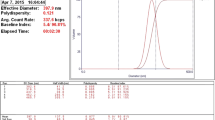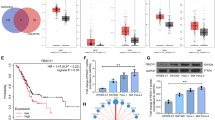Abstract
Hepatocellular carcinoma (HCC) is one of the most aggressive tumors in humans. The survival rate of patients is still very poor as current therapies offer limited treatment efficacy. Therefore, it is necessary to explore novel and more effective strategies to treat HCC. Recently, Ultrasound-targeted microbubble destruction (UTMD) has been shown to be a better alternative to viral vectors in delivering plasmid DNA into cells. In this study, we thus first determined the effect of combining UTMD with effectene on the transfection efficiency in human Hep3B cells. Transfection rate of the [effectene + shRNA-SOX9 + UTMD] group was the highest among the five groups, and were significantly higher than that of the [effectene + shRNA-SOX9] or [shRNA-SOX9 + UTMD] groups, while there was no significant difference between [shRNA-SOX9 alone] and [shRNA-SOX9 + UTMD] groups. Expression of SOX9 mRNA and protein was the lowest in effectene + shRNA-SOX9 + UTMD group. Moreover, transfection of shRNA-SOX9 with UTMD and effectene in combination could markedly inhibit the proliferation and induced cell apoptosis of Hep3B cells. These results suggest that the efficiency of gene delivery is remarkably increased when UTMD is combined with other transfection strategies, such as effectene. In conclusion, our research demonstrates that combining conventional transfection methods with UTMD achieves better transfection efficiency and that this can provide an improved gene delivery system for gene therapy.





Similar content being viewed by others
References
Sherman, M. (2010). Hepatocellular carcinoma: Epidemiology, surveillance, and diagnosis. Seminars in Liver Disease, 30(1), 3–16.
Bertino, G., et al. (2013). Systemic therapies in hepatocellular carcinoma: Present and future. Future Oncology, 9(10), 1533–1548.
Wang, Z., et al. (2013). Adjuvant therapy for hepatocellular carcinoma: Current situation and prospect. Drug Discoveries & Therapeutics, 7(4), 137–143.
Lachenmayer, A., et al. (2010). Molecular approaches to treatment of hepatocellular carcinoma. Digestive and Liver Disease, 42(Suppl 3), S264–S272.
Avila, M. A., et al. (2006). New therapies for hepatocellular carcinoma. Oncogene, 25(27), 3866–3884.
Lu, Q. L., et al. (2003). Microbubble ultrasound improves the efficiency of gene transduction in skeletal muscle in vivo with reduced tissue damage. Gene Therapy, 10(5), 396–405.
Chen, S., et al. (2006). Efficient gene delivery to pancreatic islets with ultrasonic microbubble destruction technology. Proceedings of the National Academy of Sciences, 103(22), 8469–8474.
Chumakova, O. V., et al. (2008). Composition of PLGA and PEI/DNA nanoparticles improves ultrasound-mediated gene delivery in solid tumors in vivo. Cancer Letters, 261(2), 215–225.
Iwanaga, K., et al. (2007). Local delivery system of cytotoxic agents to tumors by focused sonoporation. Cancer Gene Therapy, 14(4), 354–363.
Chen, Z., et al. (2008). Efficient gene delivery to myocardium with ultrasound targeted microbubble destruction and polyethylenimine. Journal of Huazhong University of Science and Technology, 28(5), 613–617.
Geis, N. A., et al. (2009). Spatial distribution of ultrasound targeted microbubble destruction increases cardiac transgene expression but not capillary permeability. Ultrasound in Medicine and Biology, 35(7), 1119–1126.
Xenariou, S., et al. (2007). Use of ultrasound to enhance nonviral lung gene transfer in vivo. Gene Therapy, 14(9), 768–774.
Nie, F., et al. (2006). Microbubble-enhanced ultrasound exposure improves gene transfer in vascular endothelial cells. World Journal of Gastroenterology, 12(46), 7508–7513.
Camaj, P., et al. (2014). Hypoxia-independent gene expression mediated by SOX9 promotes aggressive pancreatic tumor biology. Molecular Cancer Research, 12(3), 421–432.
Zhang, W., & Xu, H. (2014). Tailoring the RNAi efficiency of polyplexes. Bioengineered, 5(3), 152–154.
Alatzoglou, K. S., Kelberman, D., & Dattani, M. T. (2009). The role of SOX proteins in normal pituitary development. Journal of Endocrinology, 200(3), 245–258.
Zhang, Y., et al. (2012). MicroRNA-101 suppresses SOX9-dependent tumorigenicity and promotes favorable prognosis of human hepatocellular carcinoma. FEBS Letters, 586(24), 4362–4370.
Kormish, J. D., Sinner, D., & Zorn, A. M. (2010). Interactions between SOX factors and Wnt/beta-catenin signaling in development and disease. Developmental Dynamics, 239(1), 56–68.
Guo, X., et al. (2012). Expression features of SOX9 associate with tumor progression and poor prognosis of hepatocellular carcinom. Diagnostic Pathology, 7(44), 1596–1597.
Zhong, W. D., et al. (2012). SOXs in human prostate cancer: Implication as progression and prognosis factors. BMC Cancer, 12, 248.
Zhang, S., et al. (2014). Oncogenicity of the transcription factor SOX8 in hepatocellular carcinoma. Medical Oncology, 31(4), 918.
Chiu, Y. L., & Rana, R. (2003). siRNA function in RNAi: A chemical modification analysis. RNA, 9(9), 1034–1048.
Tinkov, S., et al. (2009). Microbubbles as ultrasound triggered drug carriers. Journal of Pharmaceutical Sciences, 98(6), 1935–1961.
Vlaskou, D., Plank, C., & Mykhaylyk, O. (2013). Magnetic and acoustically active microbubbles loaded with nucleic acids for gene delivery. Methods in Molecular Biology, 948, 205–241.
Author information
Authors and Affiliations
Corresponding author
Rights and permissions
About this article
Cite this article
Xue, Y., Yang, G., Wang, C. et al. Effects of shRNA-Mediated SOX9 Inhibition on Cell Proliferation and Apoptosis in Human HCC Cell Line Hep3B Mediated by Ultrasound-Targeted Microbubble Destruction (UTMD). Cell Biochem Biophys 73, 553–558 (2015). https://doi.org/10.1007/s12013-015-0685-6
Published:
Issue Date:
DOI: https://doi.org/10.1007/s12013-015-0685-6




